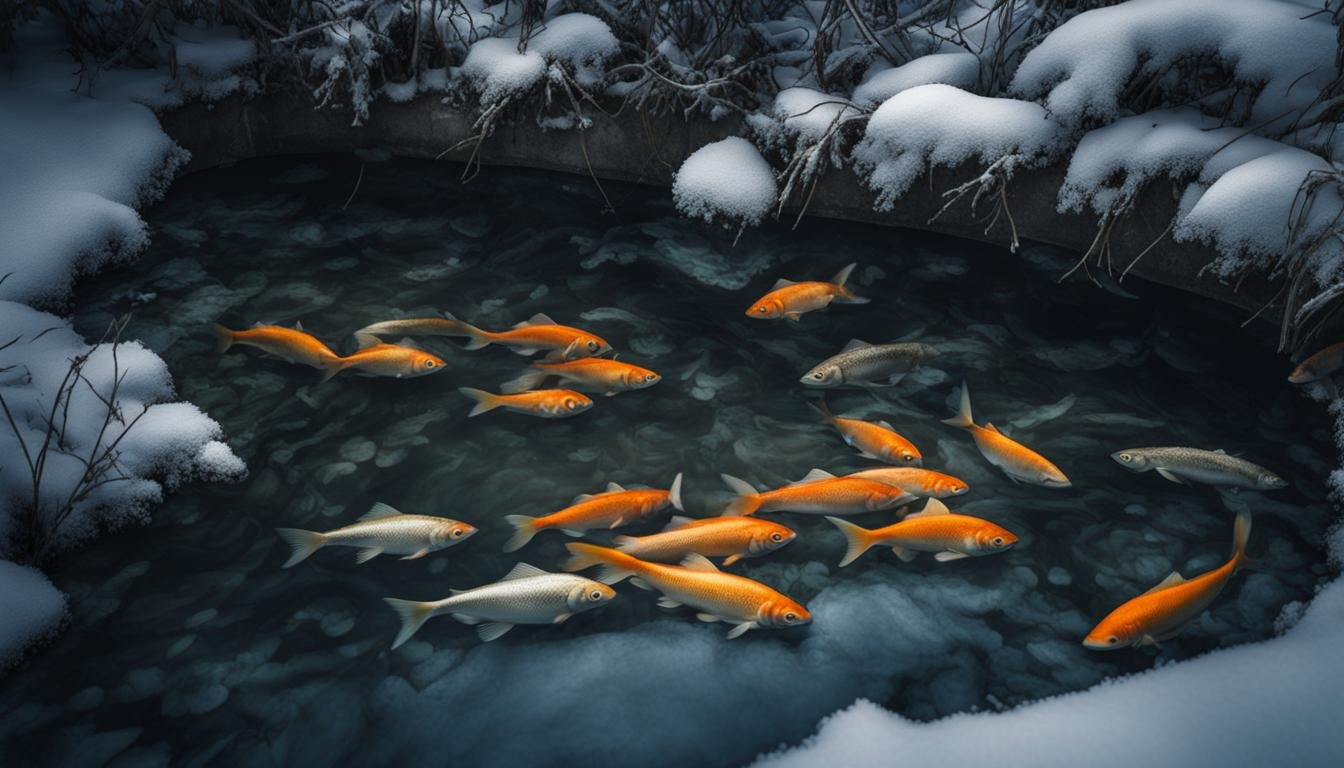Welcome to our fascinating exploration of fish behavior during the winter season. Have you ever wondered if fish hibernate like bears or other animals do?
Join us as we dive deep into the topic to uncover the aquatic winter secrets of these remarkable creatures.
Contrary to popular belief, fish do not actually hibernate in the traditional sense. While they may go through changes in behavior and metabolism during the colder months, their winter strategies are quite different from those of land-dwelling animals.
In this article, we will debunk the myth of fish hibernation and provide you with a clear understanding of how fish navigate the challenges of winter.
From exploring their adaptations to chilly temperatures and changes in their feeding patterns to understanding the role of water temperature on fish activity levels, we’ll reveal the truths behind their winter survival.
So, if you’re ready to uncover the secrets of fish behavior in the winter and unravel the myths, let’s dive in!
Key Takeaways:
- Contrary to popular belief, fish do not hibernate like bears or other animals during the winter.
- Fish employ unique adaptations and strategies to survive the challenges of winter.
- Understanding fish behavior in the winter can help us appreciate their resilience and remarkable survival capabilities.
- Water temperature plays a crucial role in shaping fish activity levels during the winter months.
- By debunking the myth of fish hibernation, we gain insight into the true nature of their winter behavior.
Demystifying the Myth of Fish Hibernation
In this section, we will explore the origins of the fish hibernation myth and how it has been perceived throughout history. Fish hibernation has been a topic of fascination and misconception for centuries, with early observations leading to inaccurate beliefs about their behavior during winter.
Historical Observations and Misconceptions
Early observations of fish behavior in winter sparked the belief that fish hibernate. People noticed fish becoming less active and gathering in groups at the bottom of bodies of water. These observations, coupled with limited scientific understanding, led to the misconception that fish underwent a deep sleep-like state during the cold months.
However, it is now understood that fish do not hibernate in the same way that mammals do. The perceived lack of movement and reduced activity can be attributed to a decrease in metabolism and slower physiological processes rather than true hibernation.
The Evolution of Science and Our Understanding
Over time, advances in scientific research and technology have allowed us to gain a better understanding of fish behavior during winter. Through in-depth studies and observations, scientists have discovered that fish employ various strategies to survive in cold temperatures, such as seeking out warmer areas and reducing their metabolism.
By studying the metabolic changes and physiological adaptations of fish in winter, we have debunked the myth of fish hibernation. While fish may exhibit reduced activity and altered behaviors, they do not enter a true state of hibernation characterized by extended periods of deep sleep and metabolic shutdown.
Understanding Fish Metabolism in Cold Water
In order to understand the behavior of fish in cold water environments, it is essential to take a closer look at their metabolism. Fish have unique adaptations that allow them to regulate their body temperature and survive in chilly temperatures.
When water temperature drops, fish experience a decrease in their metabolic rate. This is a crucial survival mechanism that helps conserve energy during the winter months. Fish metabolism slows down as a result, allowing them to navigate through the cold water with reduced energy expenditure.
Furthermore, fish have developed strategies to adapt their metabolism to cold water conditions. Their blood vessels constrict to minimize heat loss from the surface of their bodies. This helps maintain their internal temperature and prevent hypothermia.
Additionally, fish species living in cold water have higher concentrations of unsaturated fatty acids in their cell membranes. These fatty acids prevent the membranes from freezing and ensure the proper functioning of cells, even in extreme temperatures.
Understanding fish metabolism in cold water is crucial for comprehending their behavior during the winter season. It provides insight into the unique physiological adaptations they possess, enabling their survival in chilly aquatic environments.
Comparison of Fish Metabolism in Warm and Cold Water
| Warm Water | Cold Water | |
|---|---|---|
| Metabolic Rate | High | Low |
| Energy Expenditure | Higher due to increased metabolic rate | Lower to conserve energy |
| Heat Loss | Minimal | Minimized through constriction of blood vessels |
| Cell Membranes | Lower concentrations of unsaturated fatty acids | Higher concentrations of unsaturated fatty acids to prevent freezing |
This table highlights the contrasting characteristics of fish metabolism in warm and cold water environments. Fish in cold water exhibit lower metabolic rates, reduced energy expenditure, and adaptations to minimize heat loss and cellular damage.
How Do Fish Survive the Winter?
In order to survive the winter season, fish employ various strategies and adaptations to endure the chilly temperatures. One of the key phenomena that occur during this time is torpor, a state of reduced activity and metabolism that many fish enter when exposed to low water temperatures. Torpor allows fish to conserve energy and withstand the harsh winter conditions.
Fish have also developed specific adaptations to thrive in the cold. These adaptations include:
- Antifreeze proteins: Certain fish species produce antifreeze proteins that prevent the formation of ice crystals within their bodies, allowing them to survive in sub-zero temperatures.
- Slowed metabolism: Fish can slow down their metabolism during winter, reducing their energy requirements and enabling them to survive on limited food resources.
- Insulated bodies: Some fish have a thick layer of fat or extra scales that help insulate their bodies, providing protection against the cold.
- Migration to deep waters: In regions with deep lakes or oceans, fish may migrate to deeper waters where the temperatures are more stable and less affected by freezing.
- Suspended animation: Certain fish species are capable of entering a state of suspended animation or diapause, where their growth and activity are temporarily halted until favorable conditions return.
These adaptations and strategies play a crucial role in enabling fish to survive the winter and ensure their long-term survival. By understanding how fish navigate the challenges of the cold season, we gain a greater appreciation for the remarkable resilience and adaptability of aquatic life.
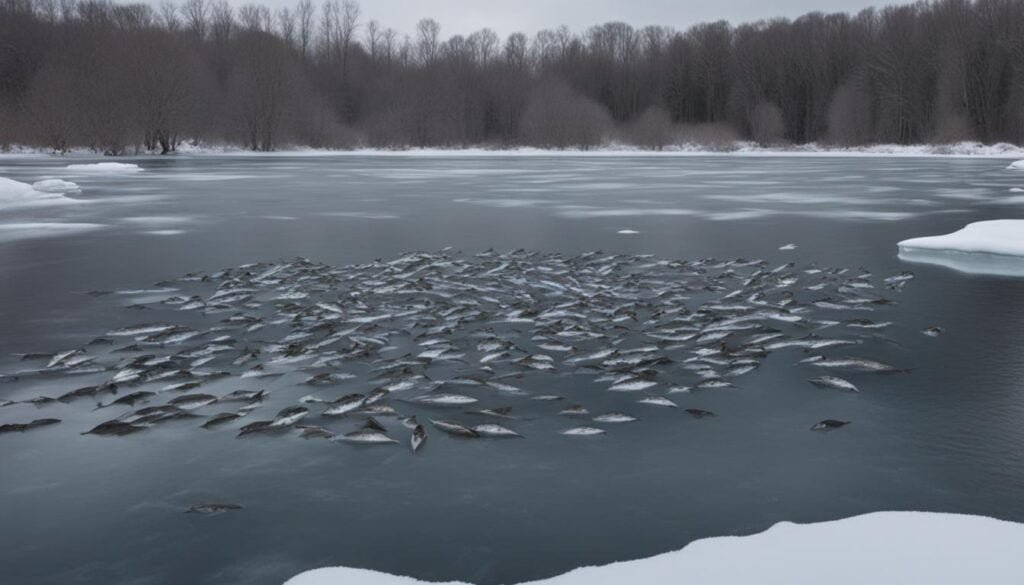
The Varied Winter Behavior of Freshwater vs Saltwater Fish
Distinct Adaptations across Diverse Habitats
Freshwater and saltwater fish exhibit unique winter behaviors and have distinct adaptations that enable them to survive in their respective habitats. These adaptations are critical for their survival during the colder months.
Freshwater fish, such as trout and catfish, often seek out deeper parts of lakes and rivers where the water temperature remains relatively stable. They also tend to slow down their metabolism, allowing them to conserve energy. Some species of freshwater fish, such as certain types of carp, can even survive under a layer of ice by obtaining oxygen from the water or by producing their own anti-freeze proteins.
Saltwater fish, on the other hand, face different challenges in the colder months. Many saltwater fish undertake long migrations to warmer waters, where they can find abundant food and favorable temperatures. These migrations help them avoid the colder regions and ensure their survival. Furthermore, some saltwater fish, like certain species of cod, have the ability to produce an anti-freeze protein that prevents ice crystal formation in their bodies.
These distinct adaptations across diverse habitats demonstrate the remarkable ability of fish to adapt and survive in varied environments. Whether it’s the ability to slow down metabolism, extract oxygen from frozen waters, or undertake migrations to warmer waters, freshwater and saltwater fish have evolved unique strategies to cope with the challenges of winter.
The Role of Water Temperature on Fish Activity Levels
In understanding fish behavior during winter, the role of water temperature cannot be overlooked. Water temperature plays a crucial role in determining the activity levels of fish during the colder months. As water temperature drops, fish undergo physiological and behavioral changes to adapt to the changing environment.
When water temperatures decrease, fish metabolism slows down, affecting their energy levels and overall activity. Cold water reduces the metabolic rate of fish, leading to a decrease in their movement and feeding patterns. As a result, fish activity levels tend to decrease during winter.
The impact of water temperature on fish behavior is not uniform across all species. Different fish species have different tolerances for cold water temperatures and may exhibit varying activity levels based on their adaptations. Some fish, such as trout, are more tolerant of colder temperatures and may continue to exhibit moderate levels of activity even in frigid waters. On the other hand, species like bass or catfish may become more lethargic as water temperatures drop.
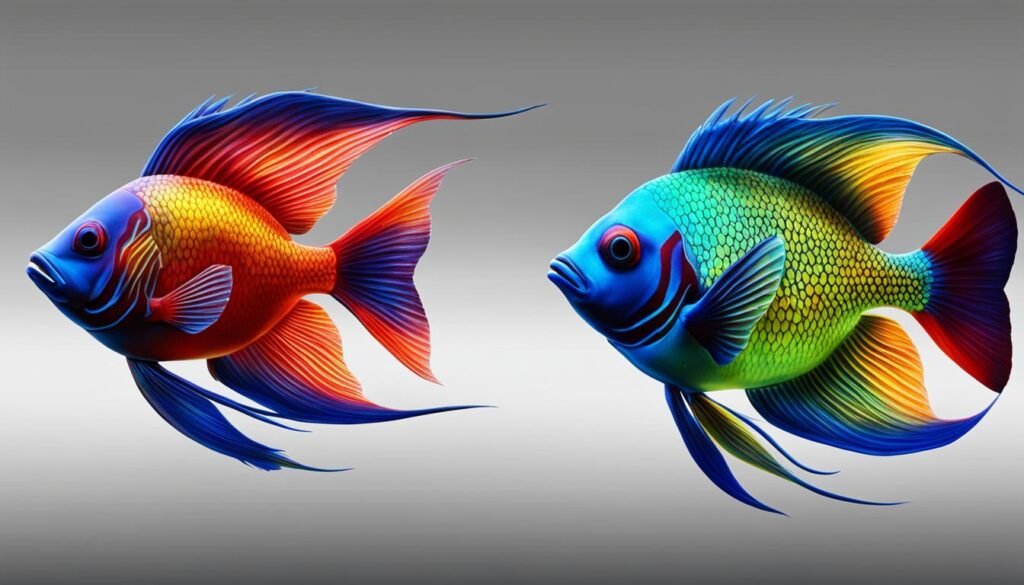
It is important to note that changes in water temperature do not solely determine fish activity levels. Other factors, such as food availability, oxygen levels, and the presence of predators, also contribute to fish behavior during winter. Therefore, the relationship between water temperature and fish activity is complex and influenced by a combination of factors.
To better understand the effect of water temperature on fish behavior, researchers use data loggers and monitoring equipment to measure and record water temperature in different aquatic habitats. This data helps in identifying the thresholds at which fish activity levels change and provides valuable insights into their winter behavior.
In conclusion, water temperature plays a significant role in determining fish activity levels during winter. As water temperature decreases, fish metabolism slows, resulting in reduced movement and feeding patterns. However, the impact of water temperature on fish behavior varies among different species. To fully grasp the nuances of fish activity in winter, it is important to consider the interplay of water temperature with other environmental factors. Understanding these dynamics is essential in preserving and managing fish populations in diverse aquatic ecosystems.
Behavioral and Physiological Changes in Fish During Winter
During the winter season, fish undergo significant behavioral and physiological changes to adapt to the harsh conditions of their environment. These changes are crucial for their survival and enable them to conserve energy and overcome the challenges posed by a frozen landscape.
Conserving Energy Through Reduced Movement
In order to conserve energy, fish reduce their movement during the winter months. This is a physiological adaptation that allows them to minimize energy expenditure and survive on limited resources. By slowing down their metabolic processes and reducing their activity levels, fish can conserve the energy they need to endure the cold temperatures.

This image depicts a fish in a frozen landscape, highlighting their need to conserve energy through reduced movement.
By minimizing unnecessary movements, fish can decrease their oxygen consumption and metabolic rate. This helps them cope with the limited food availability and decreased metabolic activity that often occurs in winter. By employing this energy-saving strategy, fish can conserve valuable resources and increase their chances of survival until the arrival of warmer temperatures.
Altered Feeding Patterns in a Frozen Landscape
In a frozen landscape, the availability of food sources is greatly reduced, leading to a significant impact on fish feeding patterns. During the winter months, fish adapt by altering their feeding behaviors to match the limited resources in their environment.
Some fish, like certain species of trout, switch to a more opportunistic feeding strategy, targeting small prey that is still available in frozen streams and lakes. They may rely on insect larvae or other aquatic organisms that can survive beneath the ice. Other fish, such as certain species of carp, may shift to consuming plant matter or detritus found at the bottom of frozen water bodies.
This altered feeding pattern allows fish to utilize available resources efficiently and sustain themselves during the winter season. By adapting their diet to match the limited food sources, fish can survive even in environments where traditional prey items are scarce.
A table can be used to showcase specific examples of altered feeding patterns in different fish species:
| Fish Species | Altered Feeding Pattern |
|---|---|
| Trout | Opportunistic feeding on small prey beneath the ice |
| Carp | Consuming plant matter and detritus at the bottom of frozen water bodies |
| Perch | Feeding on small invertebrates and zooplankton near the surface |
This table highlights the different feeding adaptations exhibited by various fish species in response to the frozen landscape.
In conclusion, fish undergo behavioral and physiological changes during the winter season to adapt to the challenges of a frozen landscape. By conserving energy through reduced movement and altering their feeding patterns, fish can survive and thrive until the arrival of warmer temperatures. Understanding these adaptations provides valuable insights into the resilience of fish in harsh winter conditions.
What Do Fish Hibernate?
While it is a common misconception that all fish hibernate during the winter, the truth is that only certain species have the ability to enter a true state of hibernation. These hibernating fish species have specific characteristics and behaviors that enable them to survive the cold temperatures and reduced food availability during the winter months.
One example of a hibernating fish species is the bullhead catfish (genus Ameiurus). These catfish are known to burrow into the mud at the bottom of lakes and rivers, where they enter a state of torpor. During this time, their metabolic activity decreases significantly, allowing them to conserve energy and survive with minimal food intake.
Another hibernating fish species is the burbot (Lota lota). These freshwater fish are well-adapted to cold environments and have the ability to reduce their metabolic rate by as much as 75% during hibernation. Burbot typically seek out deep, quiet areas of lakes and rivers during the winter, where they remain relatively inactive until the water temperature begins to rise in the spring.

In addition to bullhead catfish and burbot, other examples of hibernating fish species include certain species of trout, salmon, and sturgeon. These fish species exhibit similar behaviors, such as finding sheltered areas and reducing their metabolic activity, in order to survive the winter.
It is important to note that not all fish hibernate in the same way. Some fish species may enter a state of torpor, while others may simply slow down their metabolic activity without fully hibernating. The specific hibernation behaviors and adaptations of different fish species contribute to their ability to survive in diverse aquatic environments.
Understanding which fish species hibernate during the winter can provide valuable insights into the mechanisms and strategies that fish have developed to cope with the challenges of the cold season. By studying these hibernating fish species, researchers can gain a better understanding of the physiological and behavioral adaptations that enable fish to survive in extreme environmental conditions.
Strategies Fish Employ to Survive Winter’s Harshness
During the harsh winter months, fish must employ various strategies to ensure their survival. These adaptive behaviors allow them to withstand the cold temperatures and unpredictable conditions of their aquatic habitats.
Finding Nooks and Warmer Lake Bottoms
One effective strategy that fish utilize is finding nooks and warmer lake bottoms. In lakes and ponds, water temperatures tend to be colder near the surface and warmer closer to the lake bottom. By seeking out these warmer areas, fish can conserve energy and avoid the freezing cold water near the surface. Nooks, such as under submerged logs or within rock crevices, provide additional shelter from the harsh elements.
As fish navigate their environment, they instinctively search for these protective hideouts where they can seek refuge from the winter chill. By finding these nooks and warmer lake bottoms, fish can reduce their metabolic rate and conserve energy, ensuring their survival until the arrival of spring.
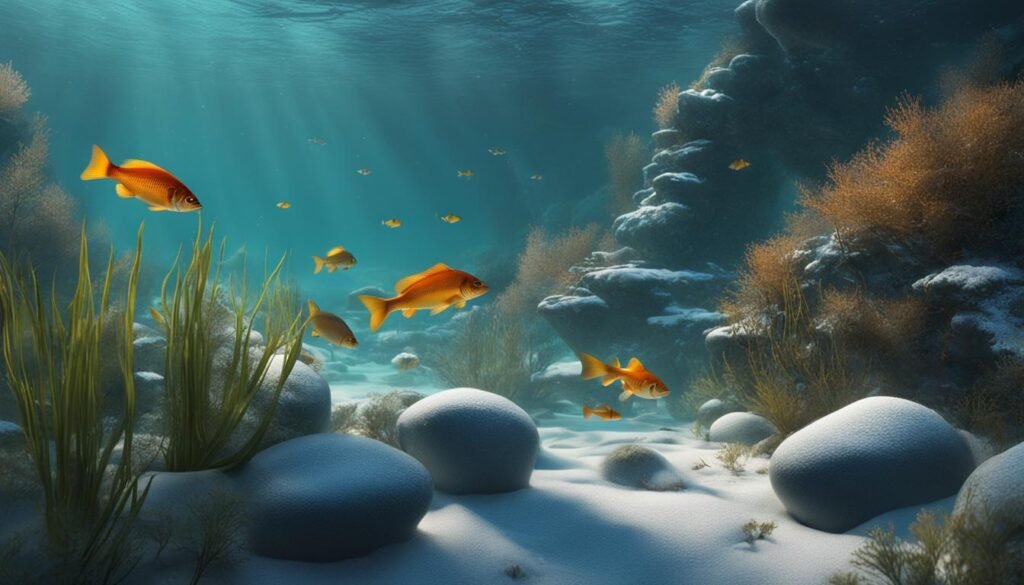
The Importance of Stable Habitats and Hideouts
Stable habitats and hideouts play a crucial role in fish survival during the winter season. These habitats provide essential protection from the elements, predators, and fluctuations in water temperature. They serve as safe havens where fish can rest, conserve energy, and reduce their activity levels.
In stable habitats, such as deep pools or areas with natural debris, fish can find refuge from extreme cold and maintain a more stable environment. These habitats offer insulation and minimize exposure to freezing temperatures, thereby increasing the chances of fish survival.
Similarly, hideouts like submerged vegetation, rock formations, and artificial structures provide additional shelter for fish. These hideouts offer protection from predators and act as buffers against the harshness of winter. By utilizing stable habitats and hideouts, fish can increase their chances of surviving the winter season.
| Winter Survival Strategies | Advantages |
|---|---|
| Finding nooks and warmer lake bottoms | Conserves energy and avoids freezing cold water near the surface |
| Seeking stable habitats | Provides protection from extreme cold and minimizes temperature fluctuations |
| Utilizing hideouts | Offers shelter from predators and buffers against harsh winter conditions |
Fish Respiration Underneath Ice and Snow
In the freezing winter months, fish face the challenge of obtaining oxygen when their surroundings are covered in ice and snow. However, these resilient creatures have evolved unique adaptations and mechanisms to ensure their survival in frozen aquatic environments.
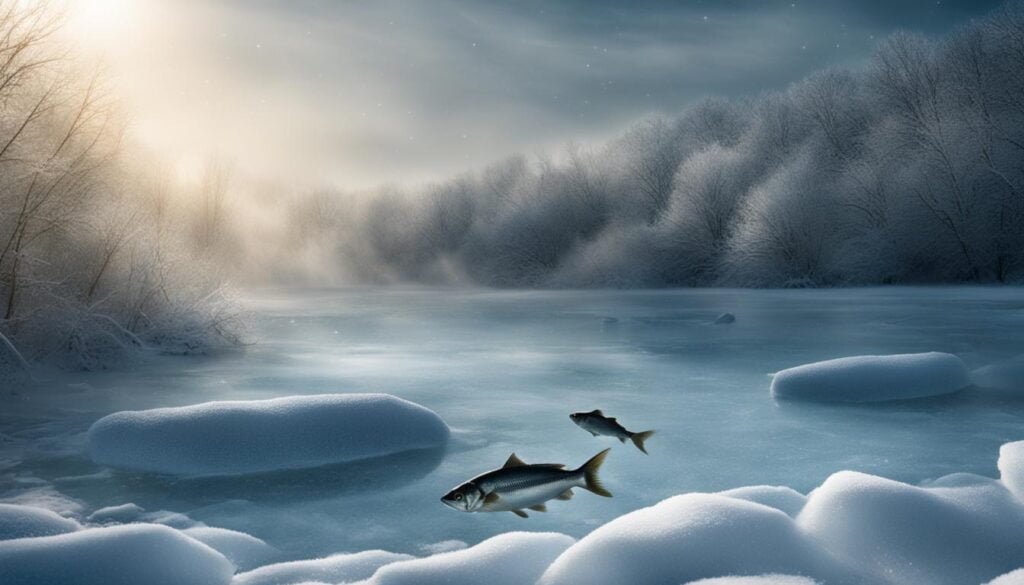
One remarkable adaptation is the ability of certain fish species to extract oxygen directly from the ice and snow. They possess specialized structures, such as pores or cells, on their skin, gills, or fins, that allow them to take in dissolved oxygen from the surrounding frozen water. This process, known as cutaneous respiration, enables fish to respire even without direct access to open water.
Additionally, fish can find small pockets or air spaces beneath the layer of ice where air is trapped. These air spaces serve as a vital oxygen source for fish during the winter months. Some species are capable of utilizing these air pockets to breathe in oxygen, similar to how humans would take a breath of air.
Furthermore, certain fish have the ability to reduce their metabolic rate and enter a state of torpor, significantly conserving energy. By slowing down their bodily functions, fish can lower their oxygen requirements, allowing them to survive with limited oxygen availability.
In summary, fish have developed remarkable adaptations and mechanisms to respire and obtain oxygen underneath ice and snow. Through cutaneous respiration, utilizing air pockets, and entering a state of torpor, fish demonstrate their incredible survival capabilities during the winter season.
Human Impact and Intervention in Fish Winter Survival
In the quest to support fish winter survival, human intervention plays a significant role. By understanding the potential impacts of our actions, we can make informed decisions that enhance the well-being of aquatic ecosystems. In this section, we will explore two common methods of intervention – de-icers and aerators – and their effects on maintaining ponds during the winter months.
The Use of De-icers
One approach to prevent the complete freezing of ponds is the use of de-icers. These devices help keep a portion of the water surface ice-free, allowing the exchange of gases between the air and water. De-icers typically consist of a heating element that prevents ice formation in a localized area. While they can be effective in maintaining open water, it’s essential to use them judiciously. Excessive or improper use of de-icers can disrupt the natural balance of the pond ecosystem, impacting fish behavior and overall winter survival.
The Role of Aerators
Aerators are another intervention method utilized to promote fish winter survival. These devices circulate and oxygenate the water, preventing stagnation and maintaining suitable oxygen levels for fish. By enhancing water movement, aerators can also prevent the formation of ice in localized areas. However, like de-icers, the installation and operation of aerators should be carefully considered. Improper use or excessive aeration can disturb the natural environment and potentially harm fish and other aquatic organisms.
It is important to note that the effectiveness of de-icers and aerators in supporting fish winter survival can vary depending on factors such as pond size, fish species present, and local climate conditions. Consulting with experts or professionals in pond management is advised to ensure the appropriate application of these intervention methods.
By understanding the potential benefits and drawbacks of human intervention through de-icers and aerators, we can make informed decisions that balance the needs of fish with the preservation of the natural aquatic ecosystem. This delicate equilibrium allows us to support fish winter survival while minimizing any negative impacts caused by our actions.
Myth vs Reality: Do Fish Actually Hibernate?
In this section, we will debunk the widely believed myth of fish hibernation and reveal the reality of their behavior during the winter months. Contrary to popular belief, fish do not hibernate in the traditional sense. Instead, they employ various survival strategies to endure the challenges of cold temperatures and limited resources.
While the notion of fish hibernation has persisted for centuries, scientific evidence has debunked this myth and shed light on the true nature of fish behavior in winter. Fish, unlike mammals that enter a prolonged dormant state, do not experience a significant reduction in their metabolic rate.
So, how do fish survive the winter? Instead of hibernating, fish employ a range of adaptations to cope with the harsh conditions. These adaptations include:
- Seeking out sheltered areas such as deeper waters or areas with vegetation to find more stable temperatures
- Reducing their activity and movements to conserve energy
- Slowing down their metabolism and entering a state of torpor
- Changing their feeding behavior to adjust to limited food availability
These strategies allow fish to withstand the cold temperatures and endure the challenges posed by winter. While they may exhibit altered behavior and physiological changes, it is important to note that fish continue to remain active during this period, albeit at a reduced level.
By dispelling the myth of fish hibernation and understanding the reality of their winter behavior, we can gain a deeper appreciation for the resilience and adaptability of these aquatic creatures. In the next section, we will explore the specific species that exhibit true hibernation-like behavior and delve into the intricacies of their survival strategies.
Conclusion
After exploring the fascinating world of fish behavior during the winter months, it is clear that the myth of fish hibernation is just that—a myth. Fish do not hibernate in the traditional sense, but rather employ a range of unique adaptations and strategies to survive the challenges of winter.
By understanding the intricacies of fish winter behavior, we can appreciate the remarkable ways in which these aquatic creatures have evolved. Fish undergo physiological changes, such as conserving energy through reduced movement and altering their feeding patterns in frozen landscapes. They also seek out nooks and warmer lake bottoms, utilizing stable habitats and hideouts to ensure their survival.
It is important to debunk the hibernation myth and replace it with a more accurate understanding of fish survival in winter. Knowing that fish respiration continues underneath ice and snow, and that their behavior is influenced by water temperature, allows us to better appreciate their resilience and adaptability.
In conclusion, the diverse strategies employed by fish, their ability to thrive in varying aquatic environments, and their remarkable adaptations to winter’s harshness demonstrate the incredible resilience of these underwater creatures. By dispelling the myth of fish hibernation and gaining a deeper understanding of their winter behavior, we can foster a greater appreciation for the intricate world of fish survival.
FAQ
Do fish hibernate?
Fish do not hibernate in the traditional sense. While they may exhibit changes in behavior and metabolism during the winter months, it is not considered true hibernation.
What are the historical observations and misconceptions surrounding fish hibernation?
Throughout history, there have been misconceptions about fish hibernation. These beliefs stemmed from observations of fish in a torpid state during winter. However, scientific advancements have revealed that this behavior is not the same as hibernation.
How does fish metabolism adapt to cold water?
Fish have developed unique adaptations to survive in cold water environments. They regulate their body temperature and adjust their metabolism to conserve energy and cope with the chilly temperatures.
What strategies do fish employ to survive the winter?
Fish employ various strategies to survive the winter season. Many fish enter a state of torpor, reducing their activity and metabolism. Additionally, they have developed specific adaptations to thrive in the cold, such as antifreeze proteins in their blood.
How do freshwater and saltwater fish differ in their winter behavior?
Freshwater and saltwater fish have distinct adaptations and behaviors in response to winter. Freshwater fish may seek shelter in nooks and warmer lake bottoms, while saltwater fish may migrate to deeper, warmer waters.
How does water temperature affect fish activity in winter?
Water temperature plays a crucial role in determining fish activity levels during winter. Changes in water temperature can trigger specific responses in fish, influencing their behavior and movement.
What behavioral and physiological changes do fish undergo during winter?
Fish conserve energy during winter through reduced movement and altered feeding patterns. They also undergo physiological changes, such as a decrease in metabolic rate, to adapt to the frozen landscape.
Which fish species actually hibernate during winter?
There are some fish species that enter a true state of hibernation during winter. These species may lower their body temperature and slow down their metabolism to conserve energy during periods of extreme cold.
How do fish navigate winter’s harshness?
Fish employ various strategies to survive the harshness of winter. They may seek out nooks and warmer lake bottoms for shelter and protection. Stable habitats and hideouts are also crucial for their survival.
How do fish respire under ice and snow?
Fish have developed unique adaptations to obtain oxygen underneath ice and snow. They extract oxygen from their surroundings through various mechanisms, such as specialized gills and active ventilation.
What is the impact of human intervention on fish winter survival?
Human intervention, such as the use of de-icers and aerators in maintaining ponds, can affect fish behavior and survival during winter. Understanding the potential benefits and drawbacks of these interventions is crucial for supporting fish survival.
Do fish actually hibernate or is it a myth?
Fish do not hibernate in the traditional sense. While they may exhibit changes in behavior and metabolism during winter, true hibernation is not a characteristic of fish.
Source Links
- http://extremephillyfishing.blogspot.com/2012/12/do-fish-hibernate-or-not-truth-or-myth.html
- https://www.canr.msu.edu/news/a-look-below-the-ice-at-fish-behavior
- https://fullserviceaquatics.com/what-happens-to-pond-fish-in-winter/
